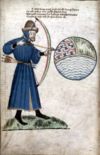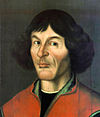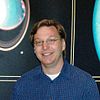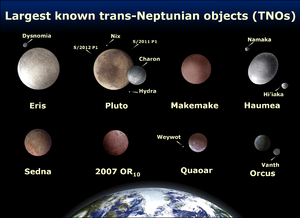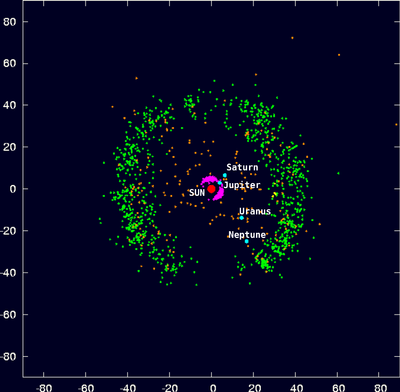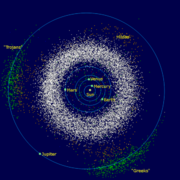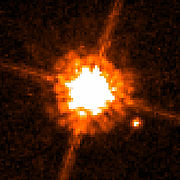
Definition of planet
Background to the schools Wikipedia
SOS Children, an education charity, organised this selection. SOS mothers each look after a a family of sponsored children.
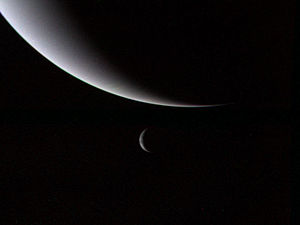
From its beginnings denoting the "wandering stars" of the classical world, the definition of "planet" has been fraught with ambiguity. In its long life, the word has meant many different things, often simultaneously. Over the millennia, use of the term was never strict and its meaning has twisted and blurred to include or exclude a variety of different objects, from the Sun and the Moon to satellites and asteroids. As knowledge of the universe grew, the word "planet" grew and changed with it, casting off old meanings and adopting new ones, though never arriving at a single, concrete definition.
By the end of the 19th century, the word "planet" had, without being defined, settled into a comfortable working term. It only applied to objects in the Solar System; a number small enough that any differences could be dealt with on an individual basis. After 1992 however, astronomers began to discover many additional objects beyond the orbit of Neptune, as well as hundreds of objects orbiting other stars. These discoveries not only increased the number of potential planets, but also expanded their variety and peculiarity. Some were nearly large enough to be stars, while others were smaller than Earth's moon. Several were nearly as large as Pluto. These discoveries challenged long perceived notions of what a planet could be.
The issue of a clear definition for "planet" came to a head in 2005 with the discovery of the trans-Neptunian object Eris, a body larger than the smallest then-accepted planet, Pluto. In its 2006 response, the International Astronomical Union (IAU), recognised by astronomers as the world body responsible for resolving issues of nomenclature, released its decision on the matter. This definition, which applies only to the Solar System, states that a planet is a body that orbits the Sun, is large enough for its own gravity to make it round, and has " cleared its neighbourhood" of smaller objects. Under this new definition, Pluto does not qualify as a planet. The IAU's decision has not resolved all controversies, and while many scientists have accepted the definition, some in the astronomical community have rejected it outright.
History
Planets in antiquity
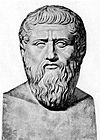
While knowledge of the planets likely predates history and is common to most civilisations, the word "planet" itself dates to ancient Greece. The Greeks believed the Earth to be stationary and at the centre of the universe in accordance with the geocentric model, and that the objects in the sky, and indeed the sky itself, revolved around it. Greek astronomers employed the term asteres planetai, "wandering stars", to describe those starlike lights in the heavens that moved over the course of the year, in contrast to the asteres aplanis, the "fixed stars", which stayed motionless relative to one another. The five bodies currently called "planets" that were known to the Greeks are Mercury, Venus, Mars, Jupiter, and Saturn.
Graeco-Roman cosmology commonly considered seven planets, with the Sun and the Moon counted among them (as is the case in modern astrology); however, there is some ambiguity on that point, as many ancient astronomers distinguished the five starlike planets from the Sun and Moon. As the 19th century German naturalist Alexander von Humboldt noted in his work Cosmos,
Of the seven cosmical bodies which, by their continually varying relative positions and distances apart, have ever since the remotest antiquity been distinguished from the "unwandering orbs" of the heaven of the "fixed stars", which to all sensible appearance preserve their relative positions and distances unchanged, five only -Mercury, Venus, Mars, Jupiter and Saturn- wear the appearance of stars- "cinque stellas errantes"- while the Sun and Moon, from the size of their disks, their importance to man, and the place assigned to them in mythological systems, were classed apart.
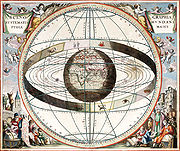
In his Timaeus, written in roughly 360 BC, Plato mentions, "the Sun and Moon and five other stars, which are called the planets". His student Aristotle makes a similar distinction in his On the Heavens: "The movements of the sun and moon are fewer than those of some of the planets". In his Phaenomena, which set to verse an astronomical treatise written by the philosopher Eudoxus in roughly 350 BC, the poet Aratus describes "those five other orbs, that intermingle with [the constellations] and wheel wandering on every side of the twelve figures of the Zodiac."
In his Almagest written in the 2nd century, Ptolemy refers to "the Sun, Moon and five planets." Hyginus explicitly mentions "the five stars which many have called wandering, and which the Greeks call Planeta." Marcus Manilius, a Latin writer who lived during the time of Caesar Augustus and whose poem Astronomica is considered one of the principal texts for modern astrology, says, "Now the dodecatemory is divided into five parts, for so many are the stars called wanderers which with passing brightness shine in heaven."
The single view of the seven planets is found in Cicero's Dream of Scipio, written sometime around 53 BC, where the spirit of Scipio Africanus proclaims, "Seven of these spheres contain the planets, one planet in each sphere, which all move contrary to the movement of heaven." In his Natural History, written in 77 AD, Pliny the Elder refers to "the seven stars, which owing to their motion we call planets, though no stars wander less than they do." Nonnus, the 5th century Greek poet, says in his Dionysiaca, "I have oracles of history on seven tablets, and the tablets bear the names of the seven planets."
Planets in the Middle Ages
Medieval and Renaissance writers generally accepted the idea of seven planets. The standard medieval introduction to astronomy, Sacrobosco's De Sphaera, includes the Sun and Moon among the planets, the more advanced Theorica planetarum presents the "theory of the seven planets," while the instructions to the Alfonsine Tables show how "to find by means of tables the mean motuses of the sun, moon, and the rest of the planets." In his Confessio Amantis, 14th century poet John Gower, referring to the planets' connection with the craft of alchemy, writes, "Of the planetes ben begonne/The gold is tilted to the Sonne/The Mone of Selver hath his part...", indicating that the Sun and the Moon were planets. Even Nicolaus Copernicus, who rejected the geocentric model, was ambivalent concerning whether the Sun and Moon were planets. In his De Revolutionibus, Copernicus clearly separates "the sun, moon, planets and stars"; however, in his Dedication of the work to Pope Paul III, Copernicus refers to, "the motion of the sun and the moon... and of the five other planets."
Modern planets
Eventually, when Copernicus's heliocentric model was accepted over the geocentric, Earth was placed among the planets and the Sun and Moon were demoted, necessitating a conceptual revolution in the understanding of planets. As the historian of science, Thomas Kuhn, noted in his book, The Structure of Scientific Revolutions:
The Copernicans who denied its traditional title 'planet' to the sun ... were changing the meaning of 'planet' so that it would continue to make useful distinctions in a world where all celestial bodies ... were seen differently from the way they had been seen before... Looking at the moon, the convert to Copernicanism ... says, 'I once took the moon to be (or saw the moon as) a planet, but I was mistaken.'
It could be said, therefore, that Earth was the first planet of the modern era. Copernicus obliquely refers to Earth as a planet in De Revolutionibus when he says,
Having thus assumed the motions which I ascribe to the Earth later on in the volume, by long and intense study I finally found that if the motions of the other planets are correlated with the orbiting of the earth, and are computed for the revolution of each planet, not only do their phenomena follow therefrom but also the order and size of all the planets and spheres, and heaven itself is so linked together that in no portion of it can anything be shifted without disrupting the remaining parts and the universe as a whole.
Galileo also indirectly asserts that Earth is a planet in the Dialogue Concerning the Two Chief World Systems; "[T]he Earth, no less than the moon or any other planet, is to be numbered among the natural bodies that move circularly."
In 1781, the astronomer William Herschel was searching the sky for elusive stellar parallaxes, when he observed what he termed a comet in the constellation of Taurus. Unlike stars, which remained mere points of light even under high magnification, this object's size increased in proportion to the power used. That this strange object might have been a planet simply did not occur to Herschel; the five planets beyond Earth had been part of humanity's conception of the universe since antiquity. However, unlike a comet, this object's orbit was nearly circular and within the ecliptic plane. Before Herschel announced his discovery of his "comet", his colleague, British Astronomer Royal Nevil Maskelyne, wrote to him, saying, "I don't know what to call it. It is as likely to be a regular planet moving in an orbit nearly circular to the sun as a Comet moving in a very eccentric ellipsis. I have not yet seen any coma or tail to it." The "comet" was also very far away, too far away for a mere comet to resolve itself. Eventually it was recognised as the seventh planet and named Uranus after the father of Saturn.
Gravitationally induced irregularities in Uranus's observed orbit led eventually to the discovery of Neptune in 1846, and presumed irregularities in Neptune's orbit subsequently led to the search which ultimately located Pluto in 1930. Initially believed to be roughly the mass of the Earth, observation gradually shrank Pluto's estimated mass until it was revealed to be a mere five hundredth as large; far too small to have influenced Neptune's orbit at all. In 1989, Voyager 2 determined the irregularities to be due to an overestimation of Neptune's mass.
Satellites
When Copernicus placed the Earth among the planets, he also placed the Moon in orbit around the Earth, making the Moon the first natural satellite to be discovered. When Galileo discovered his four satellites of Jupiter in 1610, they lent weight to Copernicus's argument, since if other planets could have satellites, then the Earth could too. However, there remained some confusion as to whether these objects were "planets"; Galileo initially intended to name them the "Medicean stars", in honour of his patrons, the Medicis, but also referred to them as planets in his Dialogue: "Just as we see in the planets (and most palpably in the satellites of Jupiter) ...". Similarly, Christiaan Huygens, upon discovering Saturn's largest moon Titan in 1655, employed many terms to describe it, including "planeta", (planet) "stella" (star) "Luna" (moon), and the more modern "satellite". Giovanni Cassini, in announcing his discovery of Saturn's moons Iapetus and Rhea in 1671 and 1672, described them as Nouvelles Planetes autour de Saturne ("New planets around Saturn"). However, when the "Journal de Scavans" reported Cassini's discovery of two new Saturnian moons in 1686, it referred to them strictly as "satellites". When William Herschel announced his discovery of two objects in orbit around Uranus in 1787, he referred to them as "satellites" and "secondary planets". All subsequent reports of natural satellite discoveries used the term "satellite" exclusively, though the 1868 book, "Smith's Illustrated Astronomy" referred to satellites as "secondary planets".
Minor planets
One of the unexpected results of William Herschel's discovery of Uranus was that it appeared to validate Bode's law, a mathematical function which generates the size of the semimajor axis of planetary orbits. Astronomers had considered the "law" a meaningless coincidence, but Uranus fell at very nearly the exact distance it predicted. Since Bode's law also predicted a body between Mars and Jupiter that at that point had not been observed, astronomers turned their attention to that region in the hope that it might be vindicated again. Finally, in 1801, astronomer Giuseppe Piazzi found a miniature new world, Ceres, lying at just the correct point in space. The object was hailed as a new planet.
Then in 1802, Heinrich Olbers discovered Pallas, a second "planet" at roughly the same distance from the Sun as Ceres. That two planets could occupy the same orbit was an affront to centuries of thinking; even Shakespeare had ridiculed the idea ("Two stars keep not their motion in one sphere"). Even so, in 1804, another world, Juno, was discovered in a similar orbit. In 1807, Olbers discovered a fourth object, Vesta, at a similar orbital distance.
Herschel suggested that these four worlds be given their own separate classification, asteroids (meaning "starlike" since they were too small for their disks to resolve and thus resembled stars), though most astronomers preferred to refer to them as planets. This conception was entrenched by the fact that, due to the difficulty of distinguishing asteroids from yet-uncharted stars, those four remained the only asteroids known until 1845. Science textbooks in 1828, after Herschel's death, still numbered the asteroids among the planets. With the arrival of more refined star charts, the search for asteroids resumed, and a fifth and sixth were discovered by Karl Ludwig Hencke in 1845 and 1847. By 1851 the number of asteroids had increased to 15, and a new method of classifying them, by affixing a number before their names in order of discovery, was adopted, inadvertently placing them in their own distinct category. Ceres became "(1) Ceres", Pallas became "(2) Pallas", and so on. By the 1860s, the number of known asteroids had increased to over a hundred, and observatories in Europe and the United States began referring to them collectively as " minor planets", or "small planets", though it took the first four asteroids longer to be grouped as such. To this day, "minor planet" remains the official designation for all small bodies in orbit around the Sun (whether asteroid or not), and each new discovery is numbered accordingly in the IAU's Minor Planet Catalogue.
Pluto
The long road from planethood to reconsideration undergone by Ceres is mirrored in the story of Pluto, which was named a planet soon after its discovery by Clyde Tombaugh in 1930. Uranus and Neptune had been declared planets based on their circular orbits, large masses and proximity to the ecliptic plane. None of these applied to Pluto; a tiny, icy world in a region of gas giants with an orbit that carried it high above the ecliptic and even inside that of Neptune. In 1978, astronomers discovered its largest moon, Charon. This allowed astronomers to determine Pluto's mass. It was found to be much tinier than expected, smaller even than the Earth's Moon. However, it was, as far as anyone could tell, unique. Then, beginning in 1992, astronomers began to detect large numbers of icy bodies beyond the orbit of Neptune that were similar in composition and size to Pluto. They concluded that they had discovered the long-hypothesised Kuiper belt (sometimes called the Edgeworth-Kuiper belt), a band of icy debris that is the source for "short-period" comets—those with orbital periods of up to 200 years.
Pluto's orbit lay within this band and thus its planetary status was thrown into question; the precedent set by Ceres in downgrading an object from planet status because of a shared orbit led many to conclude that Pluto must be reclassified as a minor planet as well. Mike Brown of the California Institute of Technology suggested that a "planet" should be redefined as "any body in the Solar System that is more massive than the total mass of all of the other bodies in a similar orbit." Those objects under that mass limit would become minor planets. In 1999, Brian Marsden of Harvard University's Minor Planet Centre suggested that Pluto be given the minor planet number 10000 while still retaining its official position as a planet. The prospect of Pluto's "demotion" created a public outcry, and in response the International Astronomical Union clarified that it was not at that time proposing to remove Pluto from the planet list.
The discovery of several other trans-Neptunian objects approaching the size of Pluto, such as Quaoar and Sedna, continued to erode arguments that Pluto was exceptional from the rest of the trans-Neptunian population. On July 29, 2005, Mike Brown and his team announced the discovery of a trans-Neptunian object confirmed to be larger than Pluto, named Eris.
In the immediate aftermath of the object's discovery, there was much discussion as to whether it could be termed a " tenth planet". NASA even put out a press release describing it as such. However, acceptance of Eris as the tenth planet implicitly demanded a definition of planet that set Pluto as an arbitrary minimum size. Many astronomers, claiming that the definition of planet was of little scientific importance, preferred to recognise Pluto's historical identity as a planet by " grandfathering" it into the planet list.
IAU definition
The discovery of Eris forced the IAU to act on a definition. In October 2005, a group of 19 IAU members, which had already been working on a definition since the discovery of Sedna in 2003, narrowed their choices to a shortlist of three, using approval voting. The definitions were:
- A planet is any object in orbit around the Sun with a diameter greater than 2000 km. (eleven votes in favour)
- A planet is any object in orbit around the Sun whose shape is stable due to its own gravity. (eight votes in favour)
- A planet is any object in orbit around the Sun that is dominant in its immediate neighbourhood. (six votes in favour)
Since no overall consensus could be reached, the committee decided to put these three definitions to a wider vote at the IAU General Assembly meeting in Prague in August 2006, and on August 24, the IAU put a final draft to a vote, which combined elements from two of the three proposals. It essentially created a medial classification between "planet" and "rock" (or, in the new parlance, " small Solar System body"), called " dwarf planet" and placed Pluto in it, along with Ceres and Eris. The vote was passed, with 424 astronomers taking part in the ballot.
| “ | The IAU therefore resolves that planets and other bodies in our Solar System, except satellites, be defined into three distinct categories in the following way: (1) A "planet"1 is a celestial body that: (a) is in orbit around the Sun, (b) has sufficient mass for its self-gravity to overcome rigid body forces so that it assumes a hydrostatic equilibrium (nearly round) shape, and (c) has cleared the neighbourhood around its orbit. (2) A "dwarf planet" is a celestial body that: (a) is in orbit around the Sun, (b) has sufficient mass for its self-gravity to overcome rigid body forces so that it assumes a hydrostatic equilibrium (nearly round) shape2, (c) has not cleared the neighbourhood around its orbit, and (d) is not a satellite. (3) All other objects3 except satellites orbiting the Sun shall be referred to collectively as " Small Solar System Bodies". Footnotes: 1 The eight planets are: Mercury, Venus, Earth, Mars, Jupiter, Saturn, Uranus, and Neptune. The IAU further resolves: Pluto is a "dwarf planet" by the above definition and is recognised as the prototype of a new category of trans-Neptunian objects. |
” |
The IAU also resolved that "planets and dwarf planets are two distinct classes of objects", meaning that dwarf planets, despite their name, would not be considered planets.
On September 13, 2006, the IAU placed Eris, its moon Dysnomia, and Pluto into their Minor Planet Catalogue, giving them the official minor planet designations (134340) Pluto, (136199) Eris, and (136199) Eris I Dysnomia. Other dwarf planet candidates, such as 2003 EL61, 2005 FY9, Sedna and Quaoar, were left in temporary limbo until a formal decision could be reached regarding their status.
On June 11, 2008, the IAU executive committee announced the establishment of a subclass of dwarf planets comprising the aforementioned "new category of trans-Neptunian objects" to which Pluto is a prototype. This new class of objects, termed plutoids, would include Pluto, Eris and any other future trans-Neptunian dwarf planets, but excluded Ceres. The IAU also determined that, for naming purposes, only those TNOs with an absolute magnitude brighter than H = +1 would be allowed into the category. To date, only two other TNOs, 2003 EL61 and (136472) Makemake (formerly 2005 FY9), meet the absolute magnitude requirement, while other potential dwarf planets, such as Sedna, Orcus and Quaoar, do not. On July 11, 2008, the Working Group on Planetary Nomenclature included FY9 in the Plutoid class, naming it Makemake.
Acceptance of the definition
Among the most vocal proponents of the IAU's decided definition are Mike Brown, the discoverer of Eris, and Steven Soter, professor of astrophysics at the American Museum of Natural History.
In an article in the January 2007 issue of Scientific American, Soter cited the definition's incorporation of current theories of the formation and evolution of the Solar System; that as the earliest protoplanets emerged from the swirling dust of the protoplanetary disc, some bodies "won" the initial competition for limited material and, as they grew, their increased gravity meant that they accumulated more material, and thus grew larger, eventually outstripping the other bodies in the Solar System by a very wide margin. The asteroid belt, disturbed by the gravitational tug of nearby Jupiter, and the Kuiper belt, too widely spaced for its constituent objects to collect together before the end of the initial formation period, both failed to win the accretion competition.
When the numbers for the winning objects are compared to those of the losers, the contrast is quite striking; if we accept Soter's concept that each planet occupies an "orbital zone," then the least orbitally dominant planet, Mars, is larger than all other collected material in its orbital zone by a factor of 5100. Ceres, the largest asteroid, is only larger by a factor of 0.33; Pluto's ratio is even lower, at 0.07. Mike Brown asserts that this massive difference in orbital dominance leaves "absolutely no room for doubt about which objects do and do not belong."
Ongoing controversies
Despite the IAU's declaration, a number of critics remain unconvinced. The definition is seen by many as arbitrary and confusing, and a number of Pluto-as-planet proponents, in particular Alan Stern, head of NASA's New Horizons mission to Pluto, have circulated a petition among astronomers to alter the definition. His claim is that, since less than 5 percent of astronomers voted for it, the decision was not representative of the entire astronomical community. The issue of what constitutes a planet will likely remain contentious at least until 2009, when the IAU holds its next Congress in Rio de Janeiro. Even with this controversy excluded however, there remain several ambiguities in the definition.
Clearing the neighbourhood
One of the main points at issue is the precise meaning of "cleared the neighbourhood around its orbit". Alan Stern recently objected that "it is impossible and contrived to put a dividing line between dwarf planets and planets," and that since neither Earth, Mars, Jupiter, nor Neptune have entirely cleared their regions of debris, none could properly be considered planets under the IAU definition.
Mike Brown counters these claims by saying that, far from not having cleared their orbits, the major planets completely control the orbits of the other bodies within their orbital zone. Jupiter may coexist with a large number of small bodies in its orbit (the Trojan asteroids), but these bodies only exist in Jupiter's orbit because they are in the sway of the planet's huge gravity. Similarly, Pluto may cross the orbit of Neptune, but Neptune long ago locked Pluto and its attendant Kuiper belt objects, called plutinos, into a 3:2 resonance, i.e., they orbit the Sun twice for every three Neptune orbits. The orbits of these objects are entirely dictated by Neptune's gravity, and thus, Neptune is gravitationally dominant.
Whatever definition of "clearing the neighbourhood" is ultimately accepted by the IAU, it is still an ambiguous concept. Mark Sykes, director of the Planetary Science Institute in Tucson, Arizona and organiser of the petition, explained the ambiguity to National Public Radio. Since the definition does not categorise a planet by composition or formation, but, effectively, by its location, a Mars-sized or larger object beyond the orbit of Pluto would be considered a dwarf planet, since it would not have time to clear its orbit and would therefore be surrounded by objects of similar mass, whereas an object smaller than Pluto orbiting in isolation would be considered a planet.

Hydrostatic equilibrium
The IAU's definition mandates that planets be large enough for their own gravity to form them into a state of hydrostatic equilibrium; this means that they will reach a shape that is, if not spherical, then spheroidal. Up to a certain mass, an object can be irregular in shape, but beyond that point gravity begins to pull an object towards its own centre of mass until the object collapses into a sphere. Relaxing the demand for strict sphericity was mandated by the fact that many large objects in the Solar System, such as the planets Jupiter and Saturn, the moons Mimas, Enceladus and Miranda, and the Kuiper belt object 2003 EL61, have been distorted into oblate or prolate spheroids by rapid rotation or tidal forces.
However, there is no one point at which an object can be said to have reached hydrostatic equilibrium. As Soter noted in his article,"How are we to quantify the degree of roundness that distinguishes a planet? Does gravity dominate such a body if its shape deviates from a spheroid by 10 percent or by 1 percent? Nature provides no unoccupied gap between round and nonround shapes, so any boundary would be an arbitrary choice." Furthermore, the point at which an object's mass compresses it into a sphere varies depending on the chemical makeup of the object. Objects made of ices, such as Enceladus and Miranda, assume that state more easily than those made of rock, such as Vesta and Pallas. Heat energy, from gravitational collapse, impacts, tidal forces, or radioactive decay also factors into whether an object will be spherical or not; Saturn's icy moon Mimas is spheroidal, but Neptune's larger moon Proteus, which is similarly composed but colder because of its greater distance from the Sun, is irregular.
Double planets and moons
The definition specifically excludes satellites from the category of dwarf planet, though it does not directly define the term "satellite". In the original draft proposal, an exception was made for Pluto and its largest satellite, Charon, which possess a barycenter outside the volume of either body. The initial proposal classified Pluto/Charon as a double planet, with the two objects orbiting the Sun in tandem. However, the final draft made clear that, even though they are similar in relative size, only Pluto would currently be classified as a dwarf planet.
Under the same definition, the Earth-Moon system is not formally recognised as a double planet, despite the Moon's large relative size, since the barycenter lies within the Earth. As the Moon is slowly receding from the Earth, the Earth-Moon system may eventually become a double planet system on the basis of this barycentric definition.
However, some have suggested that our Moon nonetheless deserves to be called a planet. In 1975, Isaac Asimov noted that the timing of the Moon's orbit is in tandem with the Earth's own orbit around the Sun — looking down on the ecliptic, the Moon never actually loops back on itself, and in essence it orbits the Sun in its own right.
Also many moons, even those that do not orbit the Sun directly, often exhibit features in common with true planets. Even in the late 1800's astronomers had calculated that the Galilean moons were larger than our own, with one being larger than Mercury. Saturn's moon Titan is also larger than Mercury, and even has a substantial atmosphere, thicker than the Earth's. Moons such as Io and Triton demonstrate obvious and ongoing geological activity, and Ganymede has a magnetic field. Just as stars in orbit around other stars are still referred to as stars, so some astronomers argue that objects in orbit around planets that share all their characteristics could also be called planets. Indeed Mike Brown makes just such a claim in his dissection of the issue, noting that there is little case for describing an object 400 km across with little internal geological activity as a planet if a 5000 km object with methane lakes, cryovolcanism and storms (i.e. Titan) is called a moon.
Extrasolar planets and brown dwarfs
The IAU's definition of planet applies only to objects within our own Solar System. The more than 200 extrasolar planets (planet-sized objects in orbit around other stars) were excluded as too complex an issue to be resolved during the congress. However, any future definition will need to include them, as their discovery has widened the debate on the nature of planethood in unexpected ways. Many of these planets are of considerable size, approaching the mass of small stars, while many newly-discovered brown dwarfs are conversely small enough to be considered planets.
Traditionally, the defining characteristic for starhood has been an object's ability to fuse hydrogen in its core. However, stars such as brown dwarfs have always challenged that distinction. Too small to commence sustained hydrogen fusion, they have been granted star status on their ability to fuse deuterium. However, due to the relative rarity of that isotope, this process lasts only a tiny fraction of the star's lifetime, and hence most brown dwarfs would have ceased fusion long before their discovery. Binary stars and other multiple-star formations are common, and many brown dwarfs orbit other stars. Therefore, since they do not produce energy through fusion, they could be described as planets. Indeed, astronomer Adam Burrows of the University of Arizona claims that "from the theoretical perspective, however different their modes of formation, extrasolar giant planets and brown dwarfs are essentially the same." Burrows also claims that such stellar remnants as white dwarfs should not be considered stars, a stance which would mean that an orbiting white dwarf, such as Sirius B could be considered a planet. However, the current convention among astronomers is that any object massive enough to have possessed the capability to fuse during its lifetime should be considered a star.
The confusion does not end with brown dwarfs. Maria Rosa Zapatario-Osorio et al. have discovered many objects in young star clusters of masses below that required to sustain fusion of any sort (currently calculated to be roughly 13 Jupiter masses). These have been described as " free floating planets" because current theories of Solar System formation suggest that planets may be ejected from Solar Systems altogether if their orbits become unstable.
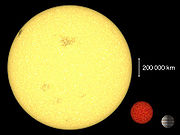
However, it is also possible that these "free floating planets" could have formed in the same manner as stars. The material difference between a low-mass star and a large gas giant is not clearcut; apart from size and relative temperature, there is little to separate a gas giant like Jupiter from its host star. Both have similar overall compositions: hydrogen and helium, with trace levels of heavier elements in their atmospheres. The generally accepted difference is one of formation; stars are said to have formed from the "top down"; out of the gases in a nebula as they underwent gravitational collapse, and thus would be composed almost entirely of hydrogen and helium, while planets are said to have formed from the "bottom up"; from the accretion of dust and gas in orbit around the young star, and thus should have cores of silicates or ices. As yet it is uncertain whether gas giants possess such cores. If it is indeed possible that a gas giant could form as a star does, then it raises the question of whether such an object, even one as familiar as Jupiter or Saturn, should be considered an orbiting low-mass star rather than a planet.
In 2003, the IAU officially released a statement to define what constitutes an extrasolar planet and what constitutes an orbiting star. To date, it remains the only official decision reached by the IAU on this issue.
| “ |
|
” |
Like defining a planet by having cleared its neighbourhood, this definition creates ambiguity by making location, rather than formation or composition, the determining characteristic for planethood. A free-floating object with a mass below 13 Jupiter masses is a "sub-brown dwarf," whereas such an object in orbit round a fusing star is a planet, even if, in all other respects, the two objects may be identical.
This ambiguity was highlighted in December 2005, when the Spitzer Space Telescope observed Cha 110913-773444 (above), the least massive brown dwarf yet found, only eight times Jupiter's mass with what appears to be the beginnings of its own star system. Were this object found in orbit round another star, it would have been termed a planet.
It was highlighted again in September 2006, when the Hubble Space Telescope imaged CHXR 73 b (left), an object orbiting a young companion star at a distance of roughly 200 AU. At 12 Jovian masses, CHXR 73 b is just under the threshold for deuterium fusion, and thus technically a planet; however, its vast distance from its parent star suggests it could not have formed inside the small star's protoplanetary disc, and therefore must have formed, as stars do, from gravitational collapse.
Criteria for determining "plutoids"
The current criterion established by the IAU for classifying an object as a "plutoid" demands that its absolute magnitude be higher than H= +1. What that effectively means is that any new plutoids will be determined not by size, but by their brightness. As Mike Brown noted in his blog, brightness is not an absolute indicator that an object has achieved hydrostatic equilibrium:
- If you take Pluto and cover it with dirt it would no longer be a Plutoid. Or take something much smaller and cover it was snow instead of rocks and it might be a Plutoid. Or, my favorite example, if you take Eris, which is currently the intrinsically brightest object, bring it closer to the sun (where it will be in 290 years), melt some of the ice on the surface, and exposure some of the darker substrate, it might just get dark enough to no longer be a Plutoid. Now you see it; now you don’t.
Semantics
Finally, from a purely linguistic point of view, there is the dichotomy that the IAU created between 'planet' and 'dwarf planet'. The term 'dwarf planet' arguably contains two words, a noun (planet) and an adjective (dwarf). Thus, the term could suggest that a dwarf planet is a type of planet, even though the IAU explicitly defines a dwarf planet as not so being. By this formulation therefore, 'dwarf planet' and 'minor planet' are best considered compound nouns. Benjamin Zimmer, of languagelog.org, summarised the confusion: "The fact that the IAU would like us to think of dwarf planets as distinct from 'real' planets lumps the lexical item 'dwarf planet' in with such oddities as ' Welsh rabbit' (not really a rabbit) and ' Rocky Mountain oysters' (not really oysters)." As Dava Sobel, the historian and popular science writer who participated in the IAU's initial decision in October 2006, noted in an interview with National Public Radio, "A dwarf planet is not a planet, and in astronomy, there are dwarf stars, which are stars, and dwarf galaxies, which are galaxies, so it's a term no one can love, dwarf planet." Mike Brown noted in an interview with the Smithsonian that, "Most of the people in the dynamical camp really did not want the word "dwarf planet," but that was forced through by the pro-Pluto camp. So you’re left with this ridiculous baggage of dwarf planets not being planets."
Conversely, astronomer Robert Cumming of the Stockholm Observatory notes that, "The name 'minor planet' been more or less synonymous with 'asteroid' for a very long time. So it seems to me pretty insane to complain about any ambiguity or risk for confusion with the introduction of 'dwarf planet'."
